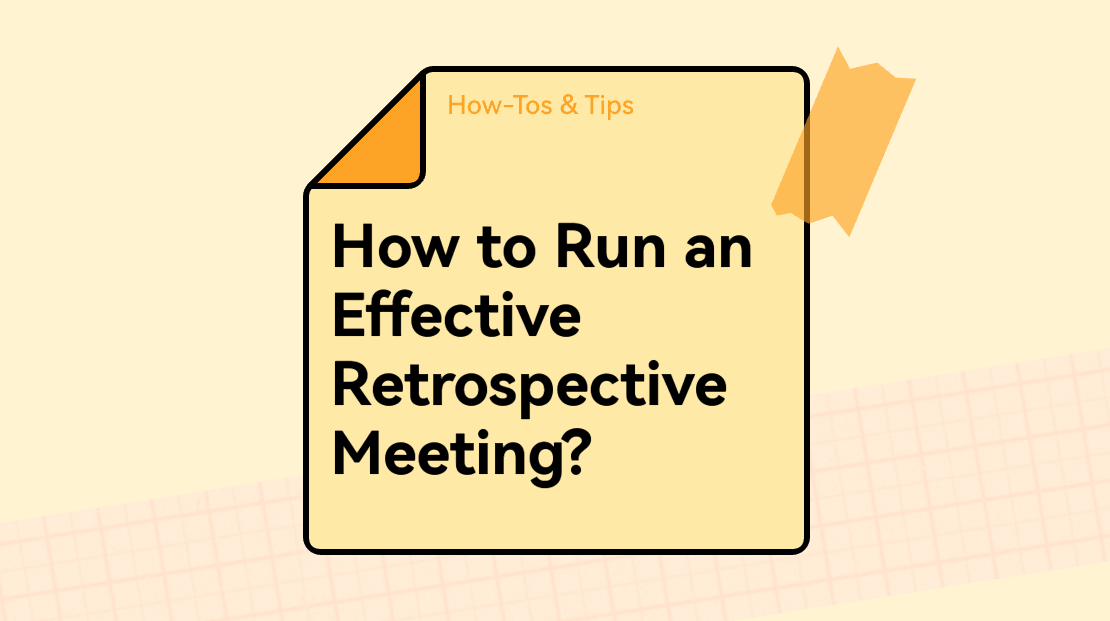Operating a successful business resembles an ongoing cycle where your team must continually adapt, excel, and innovate. It can be challenging to discern which strategies are effective and identify areas in need of improvement. That’s where the value of conducting retrospective meetings shines. These meetings serve as a vital tool for assessing your team's performance and refining your processes. Yet, mastering the art of running effective retrospectives can be a learning process. To begin your journey, this comprehensive guide serves as an invaluable resource, offering insights and techniques to enhance your retrospective meetings.

What is a retrospective meeting?
A retrospective meeting or retro is a collaborative approach to project evaluation. It's a team gathering that aims to review the overall performance, strengths, and weaknesses of any recently concluded project. This meeting helps identify which strategies are effective or lacking. From there, the team can brainstorm new ideas or reinforce existing tactics to improve their efficiency the next time around.
Project managers, scrum masters, developers, and product owners can benefit the most from knowing how to run a retrospective. This strategy is a useful tool for businesses in different industries including IT, production, and more. Scrum teams that implement Agile schemes often practice retro. The methodology allows sprints, or fast-moving development cycles, to result in better succeeding outcomes.
Every session follows a structured framework that allows team members to see the bigger picture by dissecting the details. It talks about the successes and failures of your project, which provides insight on how to enrich future collaborations.

Types of retrospectives
There are many ways you can explore how to run a retrospective meeting. You can use either one of these different types of retros or customize your structured session. Nevertheless, the meeting should reflect the project’s pros and cons, as well as key ideas that help resolve the issues. Here are the different retrospectives that you can use for your team.
Basic retrospective
Retrospectives can take on a simple format, which you can apply in any informal meeting. At its most basic outline, a retro inspects both the positives and negatives of a given situation. From there, the team can discuss thoroughly what actions can remedy the problems. It’s applicable to your day-to-day work as a team.
Project retrospective
It's good for teams to pick up the habit of reviewing recent projects consistently. This sit-down meeting is candid and brings up valid feedback from every member. More than simply listing the pros and cons, your team can deeply understand what leads to the success or failure of a project. This in-depth evaluation can help you discover opportunities that only a retro can achieve.
Traffic light retrospective
Think of driving through an intersection with traffic lights: green, orange, and red lights indicate different actions. You can apply the ‘start, continue, and stop’ signs when exploring how to run a retrospective. This metaphor can be applied as a guide to classify actions and tactics. Identify what you should and shouldn’t do, as well as activities you can pause and enhance to get better results.
Sailboat retrospective
For sprint retrospectives, a sailboat approach utilizes the metaphor of running a voyage from start to finish. That means you must break down the components of a project or initiative from when you launched it. Then, go through the specifics of the outcome and determine how well your team executed your plans.
Async retrospective
Some businesses have multiple branches with separate teams working collaboratively. In this setup, it’s challenging to use a simple retrospective framework. Since having face-to-face meetings can consume a lot of resources, time, and effort, you should consider alternatives like async retrospectives. This type is a remote setup that works perfectly for distributed teams.
In this structure, you can integrate apps like the Boardmix productivity platform to organize the session. Leveraging technology ensures that you can cover the basics of knowing how to run a retrospective meeting.
Rose, thorn, and bud retrospective
You might find this type of retro like the traffic light framework. The rose, thorn, and bud represent the different components of a project or initiative. The rose stands for the positive tactics and actions, while the thorn signifies the negative or failed strategies. The bud denotes activities that have the most potential to improve and become effective on the next implementation.
Agile retrospective
Teams working in an agile environment can use retrospectives to analyze sprints after they conclude. These short bursts of activity, which typically lasts two to four weeks, have plenty of aspects to unpack. During retro, teams can use the concept to understand what you could do differently to arrive at better results.
Anything you find out in hindsight can become a starting point for the next sprint. When that time comes, you can take the inputs gathered from the retrospective to fill the shortcomings of earlier strategies. It’s ideal for scrum teams that require fast-paced sprints to churn out the most ideal outcomes.
How to run an effective retrospective meeting
There are no strict guidelines in holding a retro since one method may work for you but not for others. Therefore, it’s safe to say that the framework can vary depending on your needs. Still, the essence of this meeting is to delve into the ins and outs of your project. That means you can follow some best practices to learn how to run a retrospective meeting efficiently.
Build a safe setting
A retrospective meeting should foster open and non-judgmental communication. It’s crucial to create an environment where team members can safely discuss their thoughts and opinions regarding the project. The only way to get the best feedback is to ensure that everyone expresses themselves honestly. You need to demonstrate that their opinions are valuable in improving the team’s future performance.
At the start, you can set out reminders that a retrospective meeting will take place once the project ends. That way, they can jot down their observations, which they can share by the end of the sprint or project.
Create an agenda
Knowing how to run a retrospective means creating a roadmap that can help you stay on track during the meeting. It’s easy to veer off topic when a healthy discussion is ongoing. You need to make a meeting agenda, which may follow the typical ‘start, continue, stop’ method. Alternatively, you can create a bespoke agenda that fits your team’s needs and requirements.
Identify your goal
Every initiative starts with a goal and specific objectives for every task. A way to evaluate your accomplishments is to ask starting questions during your retro. ‘What was the goal?’, ‘What were the initial targets we wanted to achieve?’ It’s worth mulling over the answers to these queries at the start of every retro.
Review the project
Now, you can conduct a thorough discussion of what transpired during the sprint or project. There are many ways to tackle it such as creating a timeline of tasks or activities. Ask the team members to present their observations or notes they gathered throughout the project duration. In this section, you should be able to identify the successes and failures of your iteration.
Along with these discoveries, you should also talk about the reasons behind your findings. Why did the project succeed or fail? What should you have done differently to eliminate or minimize errors? Which strategies are worth improving for your next project? Encourage your team to give their perspective on these questions to help you move to the next step of the retro meeting.
Make an action plan
Identifying what went right or wrong with your project is the key to creating an appropriate plan of action. Every issue calls for a specific solution, which you can formulate better using insights from the retrospective findings. You can devise new ideas that might help improve your team’s collaboration and future projects.

Tips for getting the most out of retrospectives
Now that you know how to run a retrospective meeting, you can apply these tips to make your retro better!
- It’s ideal to ask probing questions rather than the usual yes-or-no format. You need to look beyond surface-level opinions to find their most honest perspectives concerning the project.
- Stick to your schedule. You should set a time for your retrospectives and avoid going over your timeframe. Following a structured session ensures that your time is well spent discussing what really matters.
- You can set up an icebreaker to start the meeting on a positive note. You need to keep the participants engaged so that they can provide quality feedback for the rest of your retrospective.
- Jot down findings and other details of the session in one accessible platform. The Boardmix productivity app displays all the information, which everyone involved can access, too!
FAQs about retrospective meetings
Potential challenges of running an effective retrospective meeting
Experts who know how to run a retrospective understand that lack of honesty is one of the potential pitfalls. Sometimes, members may find it uncomfortable to share their opinions with the group. It can lead to more problems like lack of engagement and communication.
Who should be involved in a retrospective?
For a productive retrospective meeting, it's crucial to have the entire project team present. This typically includes key stakeholders such as the product owner, manager, the development team, and the scrum master, who plays the role of a skilled facilitator. Their collective insights ensure a comprehensive evaluation of the project's performance.









